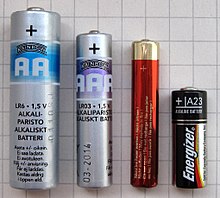difference in electrical potential between any two conductors or between a conductor and ground. A measure of the electric energy per electron that electrons can acquire and/or give up as they move between the two conductors.
This article needs additional citations for verification. (February 2018) |
Voltage, also known as (electrical) potential difference, electric pressure, or electric tension is the difference in electric potential between two points. In a static electric field, it corresponds to the work needed per unit of charge to move a positive test charge from the first point to the second point. In the International System of Units (SI), the derived unit for voltage is the volt (V).
| Voltage | |
|---|---|
 Batteries are sources of voltage in many electric circuits. | |
Common symbols | V , ∆V , U , ∆U |
| SI unit | volt |
| In SI base units | kg⋅m2⋅s−3⋅A−1 |
Derivations from other quantities | Voltage = Energy / charge |
| Dimension | |
The voltage between points can be caused by the build-up of electric charge (e.g., a capacitor), and from an electromotive force (e.g., electromagnetic induction in a generator). On a macroscopic scale, a potential difference can be caused by electrochemical processes (e.g., cells and batteries), the pressure-induced piezoelectric effect, and the thermoelectric effect. Since it is the difference in electric potential, it is a physical scalar quantity.
A voltmeter can be used to measure the voltage between two points in a system. Often a common reference potential such as the ground of the system is used as one of the points. A voltage can be associated with either a source of energy or the loss, dissipation, or storage of energy.

